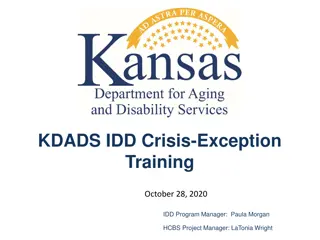Understanding Crisis Intervention and CIT in Corrections
Explore the concept of crisis intervention, the history of Crisis Intervention Teams (CIT), and the application of CIT principles in prison settings. Learn about the nature of crises, symptoms, and stages, with a focus on referring inmates to mental health services and enhancing safety within correctional facilities.
Download Presentation

Please find below an Image/Link to download the presentation.
The content on the website is provided AS IS for your information and personal use only. It may not be sold, licensed, or shared on other websites without obtaining consent from the author. Download presentation by click this link. If you encounter any issues during the download, it is possible that the publisher has removed the file from their server.
E N D
Presentation Transcript
Crisis Intervention BY LT. J. HENLEY
Lesson Goals Describe process to refer Inmates to mental health services (As a class) State the 2 primary reasons for CIT Complete 1 graded scenario (Individually)
History of CIT Police response person with a knife Memphis, TN, 1987 Joseph Dwayne Robinson, 27 Known frequent flier (High use caller) Mental health history Imminent threat Escalating tensions ignoring directives threatening officers
The Aftermath A known cutter and schizophrenic History of psychiatric hospitalizations Robinson was African American Officers were Caucasian Cutting himself and threatening officers Lethal response to legitimate threats Community outrage Could we have done more?
CIT in Prisons CIT is for street cops why do we care? While CIT was originally developed to increase safety for Officers and those afflicted with mental illness in the community .why not use CIT principals to increase safety within the prison system.
The Nature of Crisis What exactly is a crisis?: An emotionally significant event or radical change of status in a person s life. Example: Family Death Divorce Financial troubles Anything
Symptoms of a Crisis Persons suffering a crisis may show physical symptoms Ex. Appearing very upset or angry Is crying Seems very confused and/or disoriented Is withdrawn; is not interacting with or responding to other people Acts depressed Seems to be out of touch with reality
Stages of Crisis 1. Normal State: there is no crisis yet. The individual is at their baseline. 2. Stimulation: something happens to cause the person to become excited, upset, active or physically uncomfortable. 3. Crisis state: The person becomes temporarily out of control. They may scream yell, stamp feet. 4. De-Escalation: in this phase, there is gradual decrease in the crisis behaviors. 5. Stabilization (return to baseline) 6. Post-Crisis Drain or Depletion: Typically, a person in this stage is quiet, tired and/or withdrawn and may express some regret about his/her actions, including crying.
Responding to those in crisis In responding to people in crisis, never assume that a person ought or ought not to feel as he or she does in a given situation. Crisis is a matter of a person s perceptions. For example: An inmate appears to be having an emotional breakdown over something seemingly trivial ..what do you do?
Officer Safety Tactical considerations To accomplish these goals, you will possibly need to apply the concepts and skills you will learn from your department s Arrest and Control Techniques training. This is very important because when you are dealing with any emotionally disturbed person (EDP), you are going to be dealing with someone who is potentially dangerous, at least for a short period of time. The person may be angry, upset, even out-of- control, and may not be thinking clearly or rationally. Some EDP s may have a mental disorder. Certainly, most people with mental illness are not violent or dangerous, but some are particularly when they are under the influence of alcohol or drugs.
Officer Safety Signs Conspicuously ignores you Gives you excessive emotional attention Moves in an exaggerated way Ceases all movement Has a known violent history Specific pre-attack postures include: Boxer stance Hand set/clenched fists Shoulder shift Target glance The thousand-yard stare
Crisis Intervention Techniques VIDEO OF DROP THE KNIFE DROP THE KNIFE type incident here
Crisis Intervention Techniques Calm yourself Speak calmly, being assertive is fine but your goal is to de-escalate the situation Center yourself and get focused Focus on the situation at hand. Develop a strategy for the intervention Have a plan, what is the goal post de-escalation?
The Talk Try to get the person s attention. This is an important first step. You will not be able to make progress with a person in crisis unless he or she is paying adequate attention to you. Keep in mind that a person in crisis is more likely to see you rather than to hear you, at least initially.
The Talk Check on the person s perception of reality. A person in crisis may or may not perceive reality accurately. This may be particularly true of someone who is experiencing a mental disorder, but may also be true of a person who is under the influence of alcohol and/or drugs, or is in a temporary crisis for any reason.
The Talk Try to establish rapport with the person. To try to alleviate the person s fears and to get him or her to trust you, there are certain things that you can and should say to a person in crisis.
The Talk Explain Your Perception of Reality At the same time that it is important for you to try to understand the perception of reality of a person in crisis, it is also important for you to try to make clear your perception of reality to that person. This helps the other person to distinguish between what he or she is experiencing and what you are experiencing. Some people in a crisis whether based on mental disorder, alcohol or drug abuse, etc. are uncertain as to what is real or not.
The Talk Move toward Resolution of the Situation Finally, you need to try to move toward achieving a resolution of the situation. What that resolution is depends on the reason that you are there. You may have resolved the immediate crisis, and nothing more needs to be done. Or resolving the crisis may be just the initial step, and something else must follow such as taking the person to the infirmary, to the unit psychologist or placing them in segregation.
AVOID THE FOLLOWING Avoid anything that may unnecessarily escalate the situation, such as: Being overly authoritative if you do not have to do so Talking too loud or too fast, so as to frighten or confuse the subject Pointing at the person with the parental finger Laughing at the person or using derogatory words or phrases. DO NOT CALL THEM CRAZY Take your time don t rush the encounter. ETC ..
Conclusion In short, a person can be emotionally disturbed going through a crisis period for any of a number of reasons. When you are dealing with an EDP, of course, you may not know what caused the crisis and you may not know which category the person falls into. For example, when you respond to a call about a person creating a disturbance, you probably wouldn t know whether the person is mentally ill, under the influence of alcohol, or is just upset about some life situation. Fortunately, you don t need to know the reason for a crisis in order to respond to it effectively. Your job is to intervene and manage the crisis situation as best you can, not to diagnose a person s problem or to provide therapy. While in some cases it might be helpful or useful for you to know the reason behind the crisis, you will apply the same basic crisis management skills.
Scenarios 1.
References https://www.ncbi.nlm.nih.gov/pmc/articles/PMC37 69782/ http://www.citinternational.org/ http://cit.memphis.edu/ http://cit.memphis.edu/pdf/CoreElements.pdf























